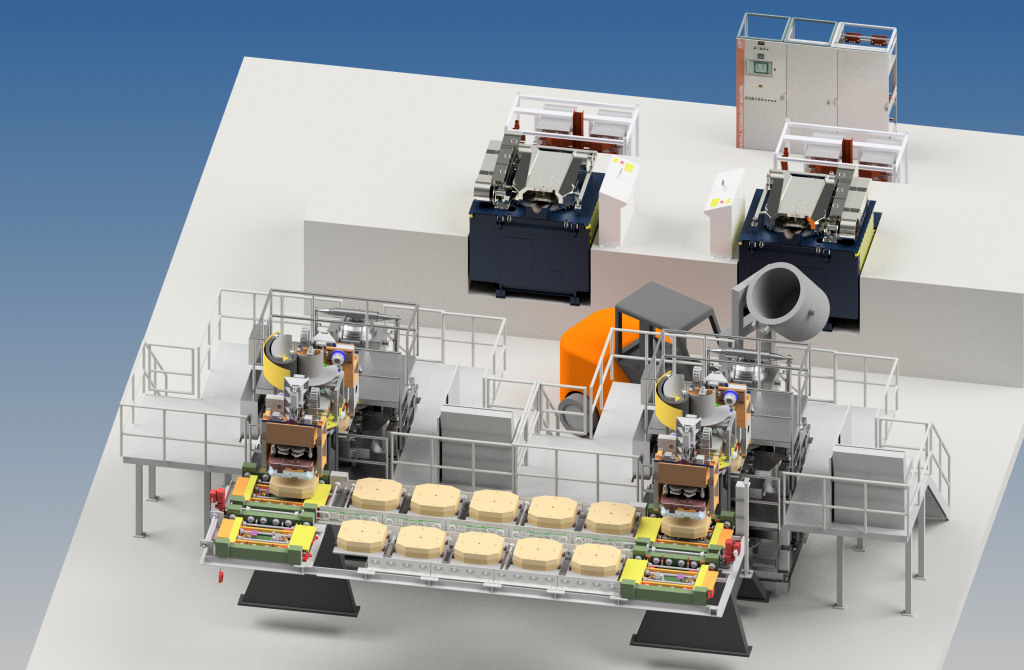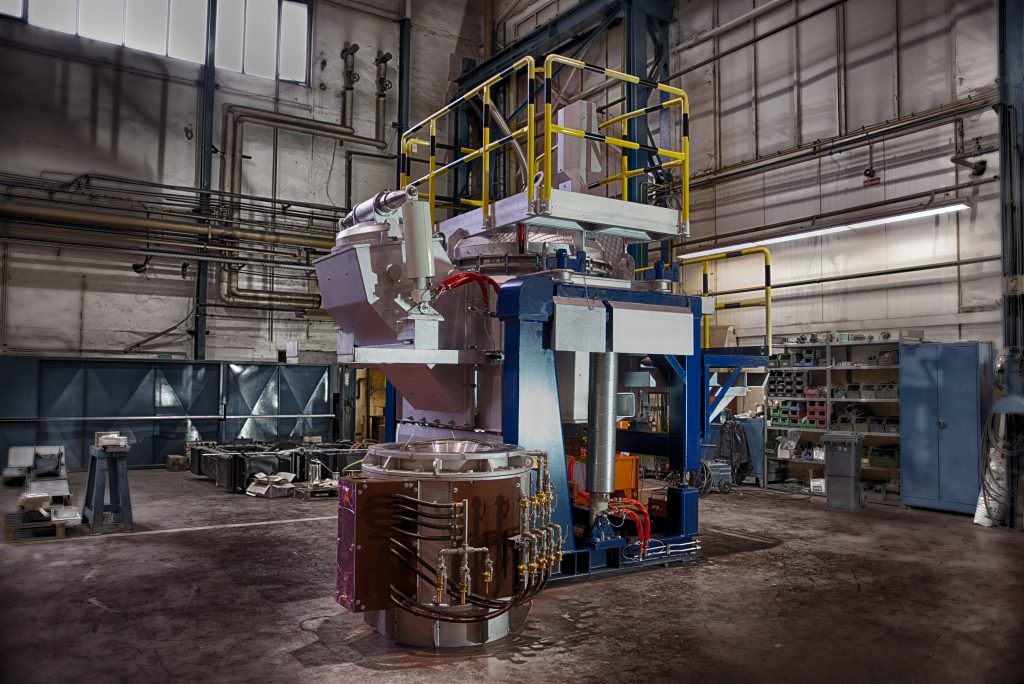Low-pressure pouring in steel pouring is the way of the future. The avoidance of mixed materials of light metals and steel makes it possible to use conventional joining processes. In addition, the importance of casting in lightweight steel construction is growing, as the CO2 emissions from steel production are up to six times lower than those from the manufacture of comparable aluminum products. ABP Induction has developed the appropriate OCN furnace system for low-pressure steel pouring following extensive preliminary tests and is already being successfully put to use. The performance of this low-pressure technology and pouring system and the resulting opportunities for the design and manufacture of steel castings will especially in the automotive sector will be presented in this blog article.

Applying low-pressure pouring to all existing molding processes
The low-pressure pouring of iron and steel materials is of particular relevance as a lightweight construction alternative to CFRP, magnesium or aluminum. This is because, in conjunction with ever more filigree and complex component geometries as well as increasing quality requirements, the process-related limitations of known pouring methods pose major challenges for designers, foundrymen and foundry engineers. Ultimately, the target geometry can only be achieved by using a large amount of recycled material with, in some cases, high reject rates. Low-pressure pouring provides a viable remedy here: The pouring process and the ABP furnace system OCN is not limited to the application for furan resin bonded core packages. The process can be employed for all established molding processes, from organic and inorganic molding material binder systems to bentonite-bonded sand casting molds and ceramic molding materials, and for all relevant alloys in steel and iron pouring. This is particularly evident in the example of cast exhaust gas turbochargers, where high-temperature-resistant cast steel materials are poured in large series in low-pressure pouring. Thus, low-pressure pouring enables established steel foundries and investment casting foundries to significantly expand their production spectrum on the one hand, while on the other hand established aluminum low-pressure foundries can broaden their range of products by adding the appropriate furnace system while retaining the remaining plant technology.
Components with a thickness of up to 0.8 millimeters have been realized in low-pressure pouring. In practice, the average for cast steel components has currently settled at 1.5 to 2 millimeters, for components with a length of up to 1.2 meters. Thanks to the precise pressure control, corresponding casting molds can be completely filled within a few seconds, without the risk of blowholes or pores if the process is properly controlled.
Low-pressure pouring thus enables complex and weight-optimized geometries to an extent similar to that of precision pouring. In comparison, the significantly lower production and finishing costs of components in low-pressure pouring, as well as the opportunity to produce thin-walled components or components with locally thin-walled and complex contours in almost any size. Transposing these production-related capabilities into an optimized design offers additional significant savings potential.
Low-pressure pouring in the automotive sector: advantages over plastics
A closer look at this potential reveals the opportunities for iron and steel: In lightweight construction, low-pressure pouring can basically outplay advantages of iron-based materials over plastics – especially when it comes to strength, recycling and material requirements. This is particularly crucial in the automotive sector with its high innovation dynamics. Pouring materials have great advantages in terms of strength and elongation and only pouring materials can be 100 percent recycled and then recast into the same high-quality product. Plastics have not managed to solve the recycling issue and the current discussion about plastics and environmental impact should benefit cast products. So a major advantage is the lower amount of recycled material needed. Not only does this mean that fewer input materials are required, but also that the costs in the downstream process steps of fettling, deburring and mechanical processing are significantly reduced. When looking at aluminum processing, the market share of low-pressure pouring is constantly on the rise.
Owing to the favorable process conditions of low-pressure pouring, the sprue and feeder system is reduced in size. The capacities saved in the melting area yield valuable savings potential or additional turnover potential for the foundries. Given the increasing focus on lightweight construction in the automotive sector, it is also particularly interesting to consider the material used. Improved drive technologies – for example efficiency measures in the combustion engine and transmission – also increase the demands on production technology. Composite materials such as CFRP and lightweight materials such as aluminum or magnesium have outstanding lightweight construction potential, but both materials have numerous disadvantages compared with steel. For one thing, the primary material is significantly more expensive and the joining technology to adjacent components is more complex, which in the case of mixed construction variants requires additional costs for corrosion protection and makes repair concepts more expensive.
Advantages of low-pressure pouring in the automotive sector: example of turbocharger housing
Also, materials such as aluminum are not suitable for all castings – such as in the case of turbocharger housings. After all, a fundamental development goal in automotive engine technology is to reduce consumption by increasing the efficiency of turbocharged gasoline engines. This results in an increase in the temperature of the exhaust gases at the engine outlet to over 1,000 degrees Celsius and higher demands on the employed materials with regard to strength, creep behavior, fatigue resistance, structural stability and oxidation resistance. As it is possible to produce steel in low-pressure pouring in a way that is load-bearing and has thinner walls, the material can bring about a significant advantage: It is easy to handle in common and globally available final assembly processes and also for repairs. This also applies to cast iron components and materials: In recent years, light-weight castings have been in great demand, especially in the iron pouring sector. One can generally say that castings are predestined for bionic constructions. This opens up further fields of application for steel pouring. Steel thin-wall technology is currently in the process of being further developed, as there are new applications that are only possible with e-mobility and are made possible by steel thin-wall casting. A number of components in the chassis area are being developed, one such example being spring supports.
In automotive engineering, focus is now shifting to structural components as well as node elements in the chassis and axle components. The principal customer industries are automotive and truck construction as well as mechanical engineering with its many sub-segments, but there are also many other special segments. Cast steel as a lightweight component or even more complex cast iron components can demonstrate their unique combination of high strength, ductility and stiffness in thin-walled and filigree production. This not only applies to passenger cars, but to the commercial vehicle sector as well. A further benefit in this area is that the stiffer structures permit higher payloads and are therefore more efficient and resource-saving in operation. Using them for engine components or rims, for instance, is also conceivable.
Gasoline engines or e-mobility? Iron casting is needed for both
Weight reduction will remain a key development goal in automotive pouring, regardless of e-mobility: Today it is becoming apparent that pouring cast solutions are still needed in both fully electric vehicles as well as conventional drives. The need for lightweight construction in cast iron, but also in thin-walled cast steel, will continue in the future alongside further optimized light metal solutions. This can be attributed to the outstanding properties of metals in terms of fatigue strength and the degrees of freedom in design using bionic constructions. In mechanical and plant engineering, various machine components up to the drives, especially for high torque motors, could be used, which in turn could also be used in the automotive industry in the future. However, the application possibilities of the low-pressure pouring process are not confined to thin-walled lightweight components. The essential advantages, such as low-turbulence mold filling, reduced gating and feeder systems and reproducible pouring conditions are equally beneficial for virtually all other areas of application in steel pouring.
In low-pressure pouring, the process is essentially encapsulated, which means that there are fewer or no problems with sparking, splashing and far less workplace stress during the pouring process. In terms of environmental and sustainability aspects, thin-walled production directly addresses high-strength lightweight construction, which helps to reduce fuel and energy consumption during operation. In terms of production, the possible wall thickness reduction in the design process further reduces material requirements and consequently energy requirements. Costly recycling processes with low reuse rates can be avoided at the end of the product life cycle by avoiding mixed construction methods or composite materials. As you can see, it is ultimately also about the interaction of these operational and environmental requirements with quality and cost factors of mass production as well as design aspects.
Environmental compatibility plays a special role in every manufacturing technology. Taken from this aspect, the shell molding process or mold carrier technology is complementary to the low-pressure pouring of iron-based materials. Together, they offer considerable savings in terms of molding material, which not only results in a saving of resources but also addresses the sensitive issue of the disposal of foundry waste. Even without the interaction with the processes mentioned above, the lower quantities of liquid material and the lower temperatures mean that the consumption of molding material can be reduced. The reduced rates of recycled and scrap material reduce the melt energy required per kilogram of good castings by up to 50 percent. In comparison with other materials and manufacturing processes, low-pressure pouring of steel and iron not only saves energy on account of the smaller quantities of input material. As the CO2 emissions from steel production are about six times lower than those from the manufacture of aluminum products for similar applications, lightweight steel casting is gaining enormously in importance, especially in times when resource and energy efficiency are of the essence.
Low pressure pouring and automotive: an outlook
Taking a look at the opportunities for iron and steel in low-pressure pouring means looking to the future. Nevertheless, a fairly clear picture emerges here based on practical experience to date alone: The requirements to implement more and more lightweight construction measures in many fields of mechanical and plant engineering are continuously on the rise. Considering these requirements, it becomes clear that conventional technologies can no longer ensure a further increase in lightweight construction potential. The increased use of lightweight construction technologies makes it possible to achieve higher material and energy efficiency and thus reduce overall costs and save resources. New business models and fields of activity can be developed for iron and steel foundries, which are particularly rooted in combustion engine technology. A practical example: Hasenclever Ironworks uses the low-pressure pouring process to develop new products. In addition to cast steel turbochargers and A- and B-pillars for car bodies, the company also produces housings for the engines of e-bikes.

Not only does the process have potential in the thin-walled and filigree area, but also where difficult contours have to be produced and new designs poured. This makes it possible to pour components that could not previously be produced geometrically as pours. ABP Induction has developed the OCN furnace system to enable the low-pressure pouring process to be used in steel pouring. This is so far the only plant for the production of cast steel using the low-pressure pouring process in industrial practice in continuous operation. Depending on the design, it offers a useful capacity of 1,000 to 10,000 kilograms. The furnace system with modern IGBT converter technology is designed for steel, iron and non-ferrous castings.
Further information:
Markus Hagedorn, ABP Induction Systems GmbH
Sales Manager Liquid Metals
Phone: +49 231 997 2295
Cell: +49 175 5538500
markus.hagedorn@abpinduction.com
